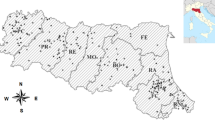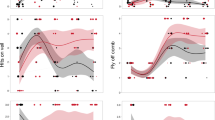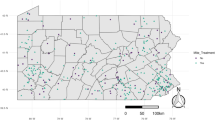Abstract
Feral and domesticated honey bees were collected across the island state of Tasmania, Australia, and typed for malate dehydrogenase and a mitochondrial DNA polymorphism. They were also compared morphometrically with reference specimens of Apis mellifera ligustica and A. m. mellifera from Europe. These measures were correlated with temperature and elevation. In warmer coastal regions, the two subspecies readily hybridize and most samples showed evidence of considerable hybridization. In cooler mountain regions, there is much less hybridization, with the A. m. mellifera subspecies characteristics strongly predominating. There is no evidence for cyto-nuclear incompatibilities between these subspecies or for clines caused by direct selection. We hypothesize that A. m. ligustica and F1 hybrids have lower fitness than A. m. mellifera in cooler regions, and that there may be assortative mating in cooler regions only. The significance of these results for the understanding of honey bee hybrid zones in Europe is discussed.
Similar content being viewed by others
Article PDF
References
Arnold, J. 1993. Cytonuclear disequilibria in hybrid zones. Ann Rev Ecol Syst, 24, 521–554.
Assmussen, M A, Arnold, J, and Avise, J C. 1987. Definition and properties of disequilibrium statistics for associations between nuclear and cytoplasmic genotypes. Genetics, 115, 775–768.
Ayton, H. 1977. The black bees of Tarraleah. In: Harnaj, V., Doull, K. and Harnaj, A. (eds) XXVI International Congress of Apiculture, pp. 266–268. Apimondia Publishing House, Bucharest.
Badino, G, Celebrano, G, and Manino, A. 1983. Population structure and MDH-1 locus variation in Apis mellifera ligustica. J Hered, 74, 443–446.
Badino, G, Celebrano, G, and Manino, A. 1984. Population genetics of Italian honeybee (Apis mellifera ligustica Spin.) and its relationships with neighbouring subspecies. Bol Mus Reg Sci Nat Torino, 2, 571–584.
Badino, G, Celebrano, G, Manino, A, and Ifantidus, M D. 1988a. Allozyme variability in Greek honey bees (Apis mellifera L.) Apidologie, 19, 377–386.
Badino, G, Celebrano, G, and Manino, A. 1988b. Genetica di popolazione delle sottospecie mediterranee di Apis mellifera L. sulla base di varianti alloenzimatiche. Apicult Mod, 79, 233–239.
Barton, N H, and Hewitt, G M. 1985. Analysis of hybrid zones. Ann Rev Ecol Syst, 16, 113–148.
Bazykin, A D. 1969. A hypothetical mechanism of speciation. Evolution, 23, 685–687.
Cale, G H, and Gowen, J W. 1956. Heterosis in the honey bee (Apis mellifera L.). Genetics, 41, 292–303.
Comparini, A, and Biasiolo, A. 1991. Genetic discrimination of Italian bee Apis mellifera ligustica from Carniolan bee, Apis mellifera carnica by allozyme variability analysis. Bio Syst Ecol, 19, 189–194.
Cornuet, J-M. 1979. The MDH system of the honey bees of Guadaloupe. J Hered, 70, 223–224.
Cornuet, J-M. 1982. Représentation graphique de populations multinormales par des ellipses de confiance. Apidologie, 13, 15–20.
Cornuet, J-M. 1983. Reproduction génétique et sélection de l'abeille. Bull Tech Apic, 10, 13–36.
Cornuet, J-M, Oldroyd, B P, and Crozier, R H. 1994. Unequal thermostability of allelic forms of malate dehydrogenase in honey bees. J Apic Res (in press).
Daly, H V, Hoelmer, K, and Gambino, P. 1991. Clinal geographic variation in feral honey bees in California, USA. Apidologie, 22, 591–607.
Endler, J A. 1977. Geographic Variation, Speciation and Clines. Princeton University Press, Princeton, New Jersey.
Garnery, L. 1992. Variabilité de l'ADN mitochondrial de l'abeille domestique implications phylogénétiques. Ph.D. Thesis, Université de Paris.
Garnery, L, Cornuet, J-M, and Solinac, M. 1992. Evolutionary history of the honey bee Apis mellifera inferred from mitochondrial DNA analysis. Mol Ecol, 1, 145–154.
Guo, S W, and Thompson, E A. 1992. Performing an exact test of Hardy-Weinberg proportion for multiple alleles. Biometrics, 48, 361–372.
Harrison, J F, and Hall, H G. 1993. African-European honeybee hybrids have low nonintermediate metabolic capacities. Nature, 363, 258–260.
Hewitt, G M. 1988. Hybrid zones: natural laboratories for evolutionary studies. Trends Ecol Evol, 3, 158–167.
Koeniger, G, Koeniger, N, Pechhacker, H, Ruttner, F, and Berg, S. 1989. Assortative mating in a mixed population of European honeybees, Apis mellifera ligustica and Apis mellifera carnica. Ins Soc, 36, 129–138.
Lindauer, M. 1961. Communication Among Social Bees. Harvard University Press, Cambridge, MA.
Meixner, M D, Sheppard, W S, and Poklukar, J. 1993. Asymmetrical distribution of a mitochondrial DNA polymorphism between two introgressing honey bee species. Apidologie, 24, 147–153.
Moore, W S. 1977. An evaluation of narrow hybrid zones in vertebrates. Quart Rev Biol, 52, 263–277.
Moore, W S, and Buchanan, D B. 1985. Stability of the northern flicker hybrid zone in historical times: implications for adaptive speciation theory. Evolution, 39, 135–151.
Nazi, F. 1992. Morphometric analysis of honey bees from an area of racial hybridization in northeastern Italy. Apidologie, 23, 89–96.
Nielson, D, Page, R E, and Crosland, M W J. 1994. Clinal variation and selection of MDH allozymes in honey bee populations. Experientia, 50, 867–871.
Oldroyd, B P, Moran, C, and Nicholas, F W. 1985. Diallel crosses of honey bees. 1. Genetic analysis of honey production using a fixed effects model. J Apic Res, 24, 243–249.
Oldroyd, B P, Rinderer, P E, and Buco, S M. 1991. Heritability of morphological characters used to distinguish European and Africanized honeybees. Theor Appl Genet, 82, 499–504.
Oldroyd, B P, Sheppard, W S, and Stelzer, J A. 1992. Genetic characterisation of the bees of Kangaroo Island, South Australia. J Apic Res, 31, 141–148.
Rice, W R. 1989. Analysing tables of statistical tests. Evolution, 43, 223–225.
Rinderer, T E, Stelzer, J A, Oldroyd, B P, Buco, S M, and Rubink, W L. 1991. Hybridization between European and Africanized honey bees in the neotropical Yucatan Peninsula. Science, 253, 309–311.
Rinderer, T E, Buco, S M, Rubink, W L, Daly, H V, Stelzer, J A, Riggio, R M, and Baptista, F C. 1993. Morphometric identification of Africanized and European honey bees using large reference populations. Apidologie, 24, 569–585.
Ruttner, F. 1968. Methods of breeding honey bees: intra-racial selection or inter-racial hybrids? Bee World, 49, 66–72.
Ruttner, F. 1976. Isolated populations of honeybees in Australia. J Apic Res, 15, 97–104.
Ruttner, F. 1988. Biogeography and Taxonomy of Honeybees. Springer, Berlin.
Ruttner, F, Tassencourt, L, and Louveaux, J. 1978. Biometrical-statistical analysis of the geographical variability of Apis mellifera L. Apidologie, 9, 363–381.
Sambrook, J, Fritsch, E F, and Maniatis, T. 1989. Molecular Cloning: A Laboratory Manual. Cold Spring Harbor Laboratory Press, Cold Spring Harbor, NY.
Sheppard, W S, Rinderer, T E, Mazzoli, J A, Stelzer, J A, and Shimanuki, H. 1991. Gene flow between African- and European-derived honey bee populations in Argentina. Nature, 349, 782–784.
Sheppard, W S, and Berlocher, S H. 1984. Enzyme polymorphism in Apis mellifera from Norway. J Apic Res, 23, 64–69.
Sheppard, W S, and Berlocher, S H. 1985. New allozyme variability in Italian honey bees. J Hered, 76, 45–85.
Smith, D R. 1991. African bees in the Americas: insights from biogeography and genetics. Trends Ecol Evol, 6, 17–21.
Smith, D R, and Brown, W M. 1990. Restriction endonuclease cleavage site and length polymorphisms in mitochondrial DNA of Apis mellifera mellifera and A. m. carnica (Hymenoptera: Apidae). Ann Ent Soc Am, 83, 81–88.
Steel, R D G, and Torrie, J H. 1980. Principles and Procedures of Statistics, 2nd edn. McGraw-Hill Kogakusha, Tokyo.
Sylvester, H A S. 1976. Allozyme Variation in Honeybees (Apis mellifera). Ph.D. Thesis, University of California at Davis.
Taylor, O R. 1977. The past and possible future spread of Africanized honeybees in the Americas. Bee World, 58, 38–47.
Author information
Authors and Affiliations
Rights and permissions
About this article
Cite this article
Oldroyd, B., Cornuet, JM., Rowe, D. et al. Racial admixture of Apis mellifera in Tasmania, Australia: similarities and differences with natural hybrid zones in Europe. Heredity 74, 315–325 (1995). https://doi.org/10.1038/hdy.1995.46
Received:
Issue date:
DOI: https://doi.org/10.1038/hdy.1995.46
Keywords
This article is cited by
-
Genetic characteristics of the Iranian honey bee, Apis mellifera meda, based on mitochondrial genes of ND4, ND4L and ND6 and their internal transcribed spacers
Insectes Sociaux (2020)
-
Population genetic structure of native Iranian population of Apis mellifera meda based on intergenic region and COX2 gene of mtDNA
Insectes Sociaux (2019)
-
Genetic origins of honey bees (Apis mellifera) on Kangaroo Island and Norfolk Island (Australia) and the Kingdom of Tonga
Apidologie (2019)
-
Mitochondrial DNA genetic diversity of honey bees, Apis mellifera, in Hawaii
Apidologie (2016)
-
Hybrid origins of Australian honeybees (Apis mellifera)
Apidologie (2016)



